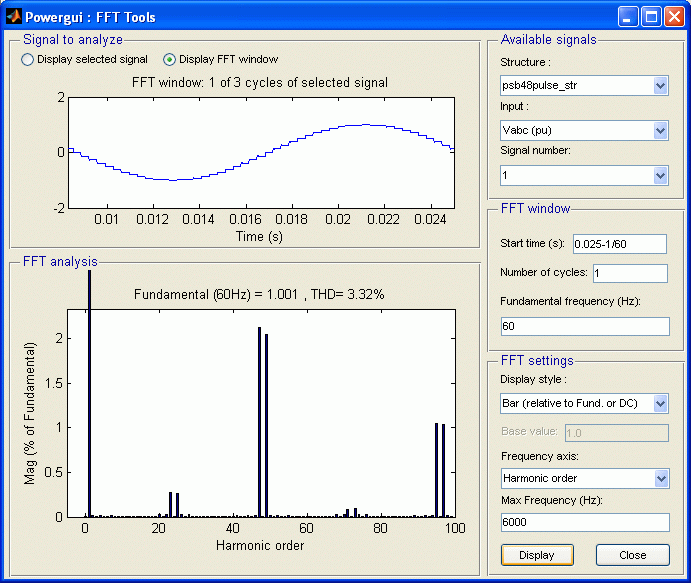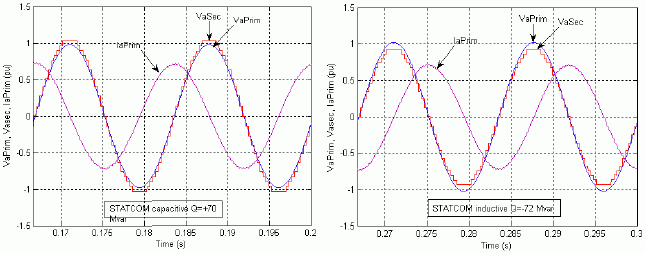GTO-Based STATCOM
Introduction
The example described in this section illustrates application of Simscape™ Electrical™ Specialized Power Systems software to study the steady-state and dynamic performance of a static synchronous compensator (STATCOM) on a transmission system. The STATCOM is a shunt device of the Flexible AC Transmission Systems (FACTS) family using power electronics. It regulates voltage by generating or absorbing reactive power. If you are not familiar with the STATCOM, refer to the Static Synchronous Compensator (Phasor Type) block documentation, which describes the STATCOM principle of operation.
Depending on the power rating of the STATCOM, different technologies are used for the power converter. High power STATCOMs (several hundreds of Mvars) normally use GTO-based, square-wave voltage-sourced converters (VSC), while lower power STATCOMs (tens of Mvars) use IGBT-based (or IGCT-based) pulse-width modulation (PWM) VSC. Due to low frequencies of electromechanical oscillations in large power systems (typically 0.02 Hz to 2 Hz), this type of study usually requires simulation times of 30–40 seconds or more.
The STATCOM model described in this example is rather a detailed model with full representation of power electronics. It uses a square-wave, 48-pulse VSC and interconnection transformers for harmonic neutralization. This type of model requires discrete simulation at fixed type steps (25 µs in this case) and it is used typically for studying the STATCOM performance on a much smaller time range (a few seconds). Typical applications include optimizing of the control system and impact of harmonics generated by converter.
Description of the STATCOM
The STATCOM described in this example is available in the STATCOM model. Load this model and
save it in your working directory as case3 to allow further
modifications to the original system. This model represents a three-bus 500 kV
system with a 100 Mvar STATCOM regulating voltage at bus B1.
The internal voltage of the equivalent system connected at bus B1 can be varied by means of a Three-Phase Programmable Voltage Source block to observe the STATCOM dynamic response to changes in system voltage.
STATCOM Power Component
The STATCOM consists of a three-level 48-pulse inverter and two series-connected 3000 µF capacitors which act as a variable DC voltage source. The variable amplitude 60 Hz voltage produced by the inverter is synthesized from the variable DC voltage which varies around 19.3 kV.
Double-click on the STATCOM 500kV 100 MVA block.
It consists of four 3-phase 3-level inverters coupled with four phase shifting transformers introducing phase shift of +/-7.5 degrees.
Except for the 23rd and 25th harmonics, this transformer arrangement neutralizes all odd harmonics up to the 45th harmonic. Y and D transformer secondaries cancel harmonics 5+12n (5, 17, 29, 41,...) and 7+12n (7, 19, 31, 43,...). In addition, the 15° phase shift between the two groups of transformers (Tr1Y and Tr1D leading by 7.5°, Tr2Y and Tr2D lagging by 7.5°) allows cancellation of harmonics 11+24n (11, 35,...) and 13+24n (13, 37,...). Considering that all 3n harmonics are not transmitted by the transformers (delta and ungrounded Y), the first harmonics that are not canceled by the transformers are therefore the 23rd, 25th, 47th and 49th harmonics. By choosing the appropriate conduction angle for the three-level inverter (σ = 172.5°), the 23rd and 25th harmonics can be minimized. The first significant harmonics generated by the inverter will then be 47th and 49th. Using a bipolar DC voltage, the STATCOM thus generates a 48-step voltage approximating a sine wave.
The following figure reproduces the primary voltage generated by the STATCOM 48-pulse inverter as well as its harmonics contents.
Frequency Spectrum of Voltage Generated by 48-Pulse Inverter at No Load

This frequency spectrum was obtained by running the Three-Phase 48-Pulse GTO Converter example, which uses the same converter topology. The FFT analysis was performed by using the FFT Analysis tool in the Powergui block. FFT uses one cycle of inverter voltage during the no-load operation and a 0–6000 Hz frequency range.
STATCOM Control System
Open the STATCOM Controller.
The control system task is to increase or decrease the capacitor DC voltage, so that the generated AC voltage has the correct amplitude for the required reactive power. The control system must also keep the AC generated voltage in phase with the system voltage at the STATCOM connection bus to generate or absorb reactive power only (except for small active power required by transformer and inverter losses).
The control system uses the following modules:
PLL (phase locked loop) synchronizes GTO pulses to the system voltage and provides a reference angle to the measurement system.
Measurement System computes the positive-sequence components of the STATCOM voltage and current, using phase-to-dq transformation and a running-window averaging.
Voltage regulation is performed by two PI regulators: from the measured voltage Vmeas and the reference voltage Vref, the Voltage Regulator block (outer loop) computes the reactive current reference Iqref used by the Current Regulator block (inner loop). The output of the current regulator is the α angle which is the phase shift of the inverter voltage with respect to the system voltage. This angle stays very close to zero except during short periods of time, as explained below.
A voltage droop is incorporated in the voltage regulation to obtain a V-I characteristics with a slope (0.03 pu/100 MVA in this case). Therefore, when the STATCOM operating point changes from fully capacitive (+100 Mvar) to fully inductive (-100 Mvar) the SVC voltage varies between 1-0.03=0.97 pu and 1+0.03=1.03 pu.
Firing Pulses Generator generates pulses for the four inverters from the PLL output (ω.t) and the current regulator output (α angle).
To explain the regulation principle, let us suppose that the system voltage Vmeas becomes lower than the reference voltage Vref. The voltage regulator will then ask for a higher reactive current output (positive Iq= capacitive current). To generate more capacitive reactive power, the current regulator will then increase α phase lag of inverter voltage with respect to system voltage, so that an active power will temporarily flow from AC system to capacitors, thus increasing DC voltage and consequently generating a higher AC voltage.
As explained in the preceding section, the conduction angle σ of the 3-level inverters has been fixed to 172.5°. This conduction angle minimizes 23rd and 25th harmonics of voltage generated by the square-wave inverters. Also, to reduce noncharacteristic harmonics, the positive and negative voltages of the DC bus are forced to stay equal by the DC Balance Regulator module. This is performed by applying a slight offset on the conduction angles σ for the positive and negative half-cycles.
The STATCOM control system also allows selection of Var control mode (see the STATCOM Controller dialog box). In such a case, the reference current Iqref is no longer generated by the voltage regulator. It is rather determined from the Qref or Iqref references specified in the dialog box.
Steady-State and Dynamic Performance of the STATCOM
You will now observe steady-state waveforms and the STATCOM dynamic response when the system voltage is varied. Open the programmable voltage source menu and look at the sequence of voltage steps that are programmed. Also, open the STATCOM Controller dialog box and verify that the STATCOM is in Voltage regulation mode with a reference voltage of 1.0 pu. Run the simulation and observe waveforms on the STATCOM scope block. These waveforms are reproduced below.
Waveforms Illustrating STATCOM Dynamic Response to System Voltage Steps

Initially the programmable voltage source is set at 1.0491 pu, resulting in a 1.0 pu voltage at bus B1 when the STATCOM is out of service. As the reference voltage Vref is set to 1.0 pu, the STATCOM is initially floating (zero current). The DC voltage is 19.3 kV. At t=0.1s, voltage is suddenly decreased by 4.5% (0.955 pu of nominal voltage). The STATCOM reacts by generating reactive power (Q=+70 Mvar) to keep voltage at 0.979 pu. The 95% settling time is approximately 47 ms. At this point the DC voltage has increased to 20.4 kV.
Then, at t=0.2 s the source voltage is increased to1.045 pu of its nominal value. The STATCOM reacts by changing its operating point from capacitive to inductive to keep voltage at 1.021 pu. At this point the STATCOM absorbs 72 Mvar and the DC voltage has been lowered to 18.2 kV. Observe on the first trace showing the STATCOM primary voltage and current that the current is changing from capacitive to inductive in approximately one cycle.
Finally, at t=0.3 s the source voltage in set back to its nominal value and the STATCOM operating point comes back to zero Mvar.
The figure below zooms on two cycles during steady-state operation when the STATCOM is capacitive and when it is inductive. Waveforms show primary and secondary voltage (phase A) as well as primary current flowing into the STATCOM.
Steady-State Voltages and Current for Capacitive and Inductive Operation

Notice that when the STATCOM is operating in capacitive mode (Q=+70 Mvar), the 48-pulse secondary voltage (in pu) generated by inverters is higher than the primary voltage (in pu) and in phase with primary voltage. Current is leading voltage by 90°; the STATCOM is therefore generating reactive power.
On the contrary, when the STATCOM is operating in inductive mode, secondary voltage is lower than primary voltage. Current is lagging voltage by 90°; the STATCOM is therefore absorbing reactive power.
Finally, if you look inside the Signals and Scopes subsystem you will have access to other control signals. Notice the transient changes on α angle when the DC voltage is increased or decreased to vary reactive power. The steady-state value of α (0.5 degrees) is the phase shift required to maintain a small active power flow compensating transformer and converter losses.